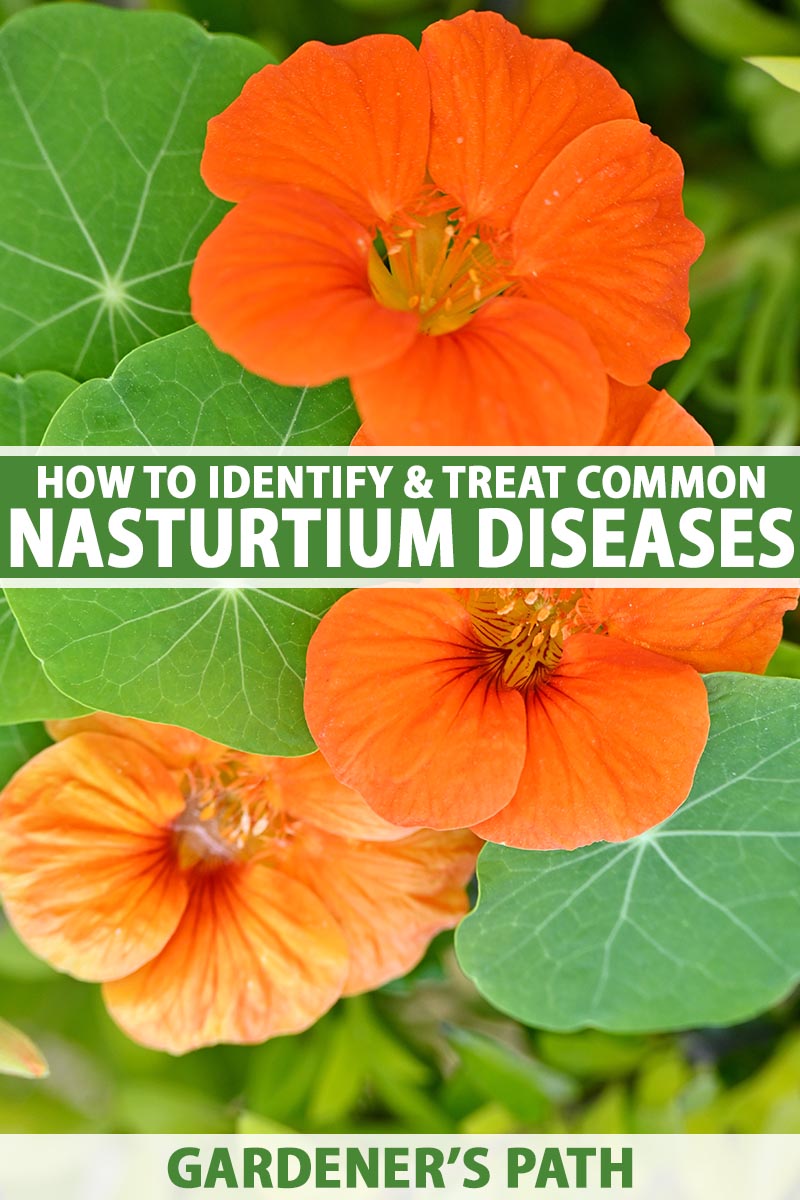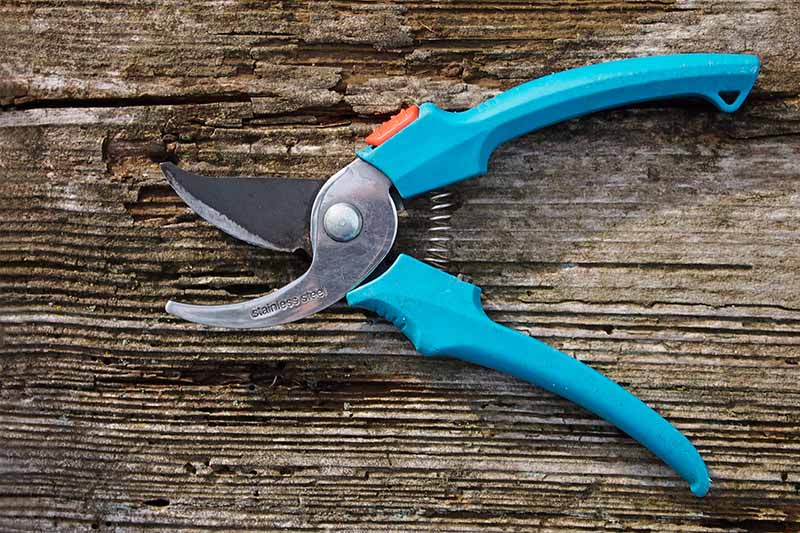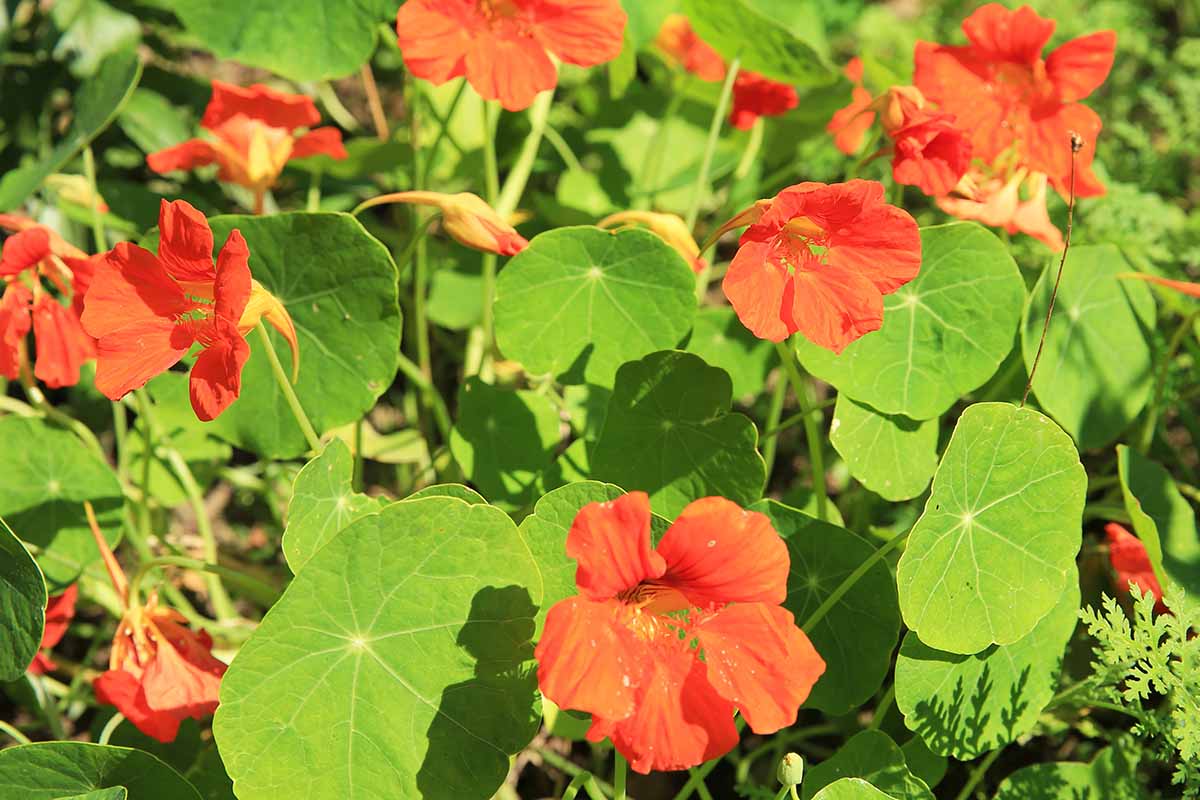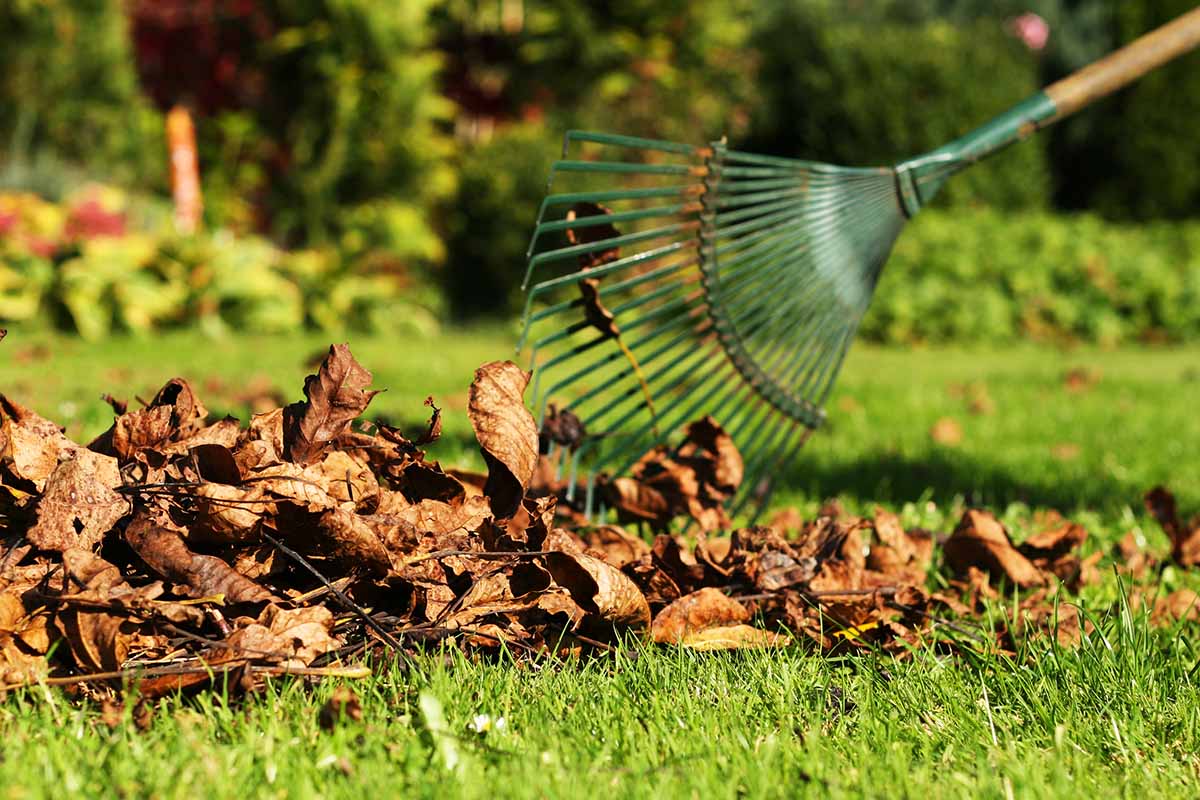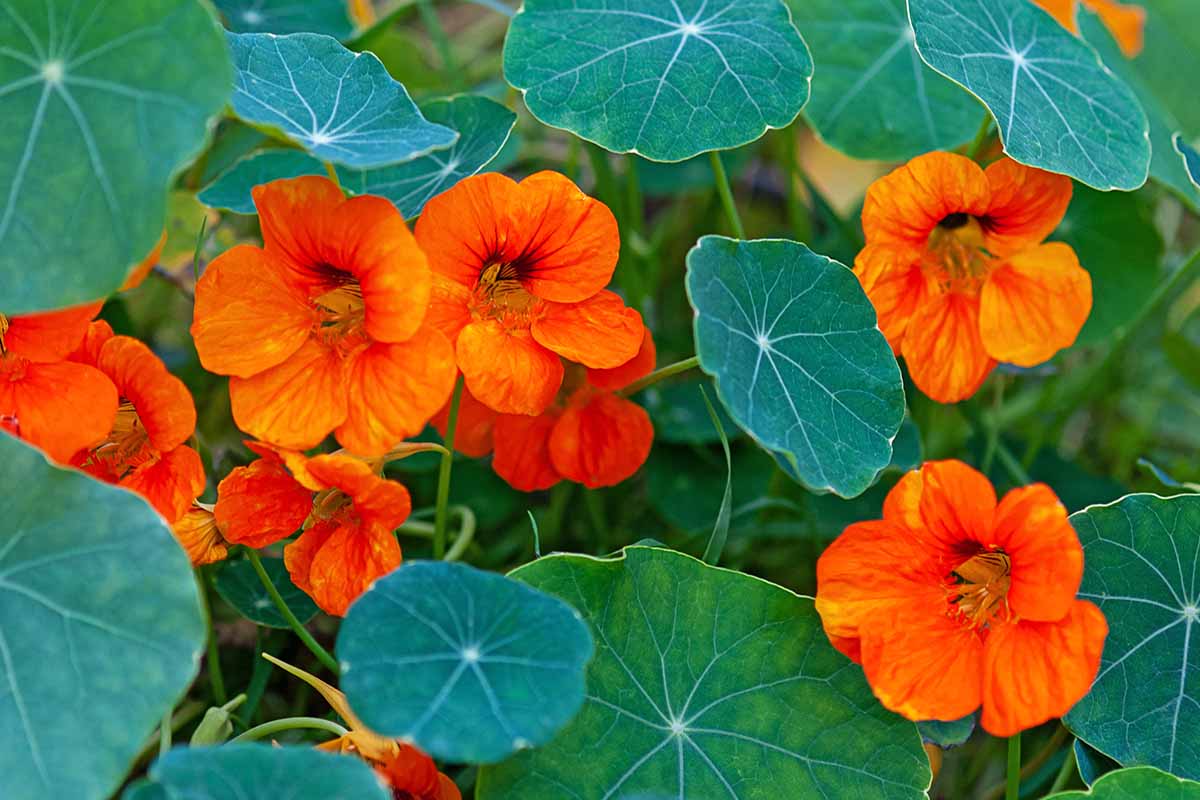‘Twas the summer of 2021, and I was working as an intern at a botanical garden. I was doing my weeding rounds in a new section of the garden, when I literally stumbled upon a Tropaeolum majus. Crouching down, I gave this strange new plant a once-over. Stunning orange flowers, petals reminiscent of a lily pad, a weird-looking yellow spur behind the petals… I was entranced. We link to vendors to help you find relevant products. If you buy from one of our links, we may earn a commission. I was taken aback, unaware that garden work came with such culinary privileges. Swallowing my surprise, I took the flower and ate it. An explosion of hot peppery goodness did a dance across my taste buds. Prior to that first bite, I never understood the appeal of foraging, a botanical hobby that didn’t make much sense to me before. Why eat a pinch of yard work at a time when I could get peanut butter by the jar? But at that moment, I got it. And my soft spot for nasturtiums has remained ever since. If you care for nasturtiums as much as I do, you’ll want to know how to keep them safe from diseases. Luckily, T. majus isn’t too prone to pathogens… but it’s not invincible. Let’s explore the basics of preventing disease in nasturtiums, and go over some specific ailments that tend to be the most common in home gardens. Here’s what awaits:
Tips for Preventing Disease
An ounce of prevention is worth a pound of cure, as they say. This rings especially true when preventing disease in nasturtiums.
Choose Pathogen-Free Plants
Whether you’re planting seeds or using transplants, ensuring that your sources are free of contamination is imperative. Talk with your sellers and vendors, and do research to make sure you’re not buying diseased nasturtiums. If the seeds you’re using are your own, saved from seasons past, make sure they didn’t come from diseased plants.
Sterilize and Sharpen Garden Implements
Pruning, digging, and propagating are just some of the gardening practices that can spread disease if the tools used to do so aren’t kept clean. Diseased sap and other juices can hitch a ride on your tools and travel to new, healthy plants. Keeping a spray bottle of rubbing alcohol on your person and spritzing your tools as needed can be a convenient way of sanitizing implements in the garden. The sharpness of said tools also aids in disease prevention. Dull blades cause larger, messier wounds, which leave wounded tissues more vulnerable to contamination. A whetstone or grindstone will help keep edges honed and ready.
Space Properly and Prune Regularly
Clumping your plants together, while utilitarian, doesn’t allow for airflow in between plantings. This reduced passage of air currents can often lead to a diseased environment. Give your nasturtiums some breathing room! In addition to maintaining an aesthetic form, pruning also allows for adequate space within each plant. To prune a nasturtium, pinch back spent flower heads and the oldest stem of any that intersect. Remove any stems that get too leggy and visually hinders the nasturtium’s clumped, mounding look.
Place in Full Sun and Irrigate Properly
Shade is more conducive to disease spread than sunlight in most cases. Putting your nasturtiums in a place where they receive full sun exposure for at least six to eight hours per day will help keep disease down. Nasturtiums prefer full sun anyway, so you’ll end up with a maximum yield of those delicious flower heads as a bonus. Excessive water is another causal agent of disease, so don’t overdo it with the irrigation. Nasturtiums like the soil moist, not soaked. A tad bit of temperance in watering will go a long way.
Dispose of Dead Plant Tissues
As shoots die, oftentimes they fall to the soil surface, or remain nestled within the rest of the living plant. The compost-obsessed gardener within us all wants nothing more than to leave that detritus alone for use as humus. This is great for fertilizing soil, but less so for keeping plantings disease-free. Fallen leaves, broken-off stems, spent flower heads… get rid of ‘em all. Rake up, pluck out, whatever you gotta do. Then throw them away or burn them if they show signs of disease.
Common Nasturtium Diseases
Here are the main diseases to worry about in the quest to keep your nasturtiums healthy. Not as many pathological enemies to worry about as you would have with, say, tomatoes… but nothing to sneeze at, either. Take heed.
Aster Yellows
Caused by phytoplasma, i.e. intracellular parasites of phloem tissues, aster yellows causes interveinal leaf chlorosis and stunted, deformed growth. The phytoplasma are primarily spread by infected leafhopper insects, which inject healthy tissues with the pathogens as they feed. Wet and cool summers provide primo conditions for the spread of this disease. Since aster yellows is incurable, terminating infected specimens with extreme prejudice is all that can be done. Surrounding your nasturtiums with mesh fabrics can keep leafhoppers off the plants, and placing reflective strips of aluminum foil between your plantings can confuse the insects. Infected weeds can become aster yellows vectors themselves, so cultivate a weed-free garden. You can learn more about aster yellows in our guide.
Bacterial Leaf Spot
Caused by various Pseudomonas species of bacteria, bacterial leaf spot causes spots of a brown or black color to appear on the leaves. The margins of leaves can also appear water-soaked. Methods of control that work against wilt also work to prevent cases of bacterial leaf spot. Cleaning up botanical detritus in autumn is another effective means of control, along with increasing air circulation within the plant via thinning.
Botrytis Blight
A disease caused by fungi in the Botrytis genus, botrytis blight causes abnormal development in buds and flowers, along with browning. Following damp, cool weather, gray mold can form on afflicted plant structures. Sanitizing planting areas, avoiding overhead watering, and providing ample airflow are all effective in preventing botrytis blight infections. Avoid fertilizing with excess nitrogen, as this promotes tender and susceptible growth. Applying fungicide every 10 days may work as a preventative measure.
Clubroot
Caused by Plasmodiophora brassicae, clubroot causes stunting, wilting, and occasional slight leaf chlorosis. Plant roots will become swollen and begin to resemble clubs, hence the name. Juvenile plants may die, while older plants will simply fail to perform well. Acquiring nasturtiums that are disease-free, sanitizing tools, and only adding heat-treated soil or compost to your plantings will help prevent clubroot infection. Remove and dispose of affected plants in the garbage right away. Since the disease survives in the soil, avoid planting in infected plots for five to seven years to prevent subsequent reinfection.
Impatiens Necrotic Spot Virus
INSV, like COVID-19, has a grab bag of symptoms so varied that the only conclusion you can draw is that something isn’t right. Symptoms include – but aren’t limited to – leaf etching, poor flowering, stem death, stunting, yellowing, wilting, and sunken spots. The only way of diagnosing an INSV infection for certain is to get a test done, either commercially or at a plant disease clinic. There is no known cure for this disease. All you can do is identify, isolate, and then destroy infected specimens. Spreading plantings around your garden can help ensure that a wave of INSV doesn’t take out all your nasturtiums in one fell swoop.
Powdery Mildew
Caused by the fungus Leveillula rutae, this was actually discovered in nasturtium fairly recently as of this writing, in 2015. Initial symptoms are yellow leaf spots, which then turn into necrotic lesions. Powdery mildew becomes readily apparent with the appearance of white fungal structures on both sides of the leaves, covering the flowers and stems as well in severe cases. It usually isn’t fatal, but the disease makes the plant weak and unable to visually perform well. Moderate temperatures and low light are causal agents, and infectious spores can spread via wind and rain. Powdery mildew can be prevented by growing in the cooler, less humid months, as well as in well-ventilated areas. Removing infected nasturtiums from the garden can help slow the spread and prevent spore movement. Horticultural oils, as well as fungicides containing potassium bicarbonate, may be used for chemical control. Learn more about how to manage powdery mildew in our guide.
Wilt
Caused by Pseudomonas solanacearum, wilt infects nasturtiums and leads to yellowing, wilting, and eventual death. Stems become streaked with black and ooze bacterial slime from cuts, while roots blacken entirely and can be points of entry for other disease pathogens that persist in plant detritus found in the soil, leading to secondary infections. Sterilizing tools, crop rotation, and avoiding overhead irrigation are all important prevention measures to take. Don’t grow nasturtiums with other plants that are also susceptible to wilt, such as zinnias, dahlias, chrysanthemums, marigolds, tomatoes, potatoes, and eggplant. Once diseased, contaminated flora should be identified, removed, and burned or disposed of in the trash. As long as diligent efforts are made to prevent disease and stop further damage from occurring once infected, your nasturtiums are in good hands. Any comments, questions, and insights about nasturtium disease are more than welcome in the comments section below! I’ll be sure to answer them to the best of my ability! If this article was helpful or intriguing to you, take a look at some of these other nasturtium guides to learn more:
How to Plant and Grow Nasturtiums15 of the Best Nasturtium VarietiesShould I Deadhead My Nasturtium Plants?
